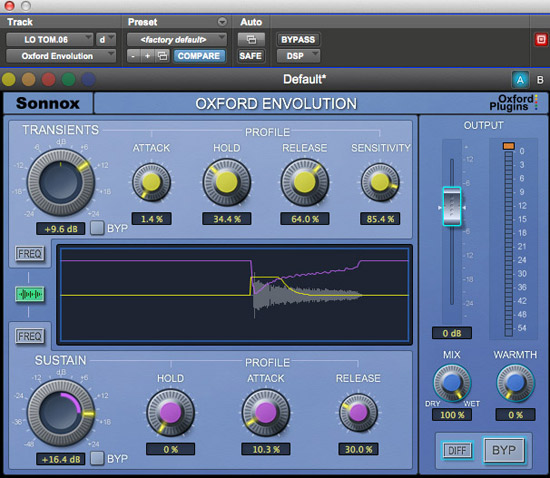|
|
Sonnox Oxford Envolution Envelope Shaper
|
|
|
 |
| Sonnox Oxford Envolution Envelope Shaper |
Both the Transient and Sustain processor sections have bypass buttons and are usable separately or at the same time with their perspective amplitude envelopes (color-coded yellow for transients and purple for sustain) displayed over a scalable time line in the GUI's Envelope Scope window.
Spectral shaping is handled in a unique fashion in Envolution. Again separate controls and GUI windows for Transient and Sustain processing sections allow for applying a tilt equalizer with a smooth, 6dB or 12dB/Oct to work as a low-pass or high-pass filter to exclude low or high frequencies from the processing. There is also the Focus mode for applying either a band-pass or a band-reject (notch filter) to either boost desired or reduce undesired frequencies from processing.
The manual points out that this feature could be thought as a frequency dependent Wet/Dry mixer for Envolution's effect.
I found the Focus mode a great way to build up the low frequencies of a kick drum track when adding sustain to it. Much different than using an EQ or a compressor, sustain is only added to a selected band of frequencies and not to the surrounding ambience or beater attacks. The Q of the Focus filter is fully adjustable up to very sharp and near resonance. Kick and snare drum sounds (especially isolated samples) can be completely reshaped into totally new and extreme sounds. Sound designers and re-mixers take note!
Besides the Envelope scope with its Frequency windows, Envolution has the DIFF Listen mode button. I recognize this feature from the Sonnox Fraunhofer Pro-Codec Version 3 encoder/decoder plug-in. DIFF lets you hear exactly the difference from original input signal and the transient/sustain processing signal only. Not a bypass button (although there is a master bypass button) besides optimizing your settings easily, DIFF allows for extracting only transient signals for triggering other sounds or pulling out non-transient sustaining signals. Using and listening in DIFF, you can produce extreme negative-ratio compression trickery. This is a yet to be explored region of sound design for me--for now anyway.
By being able to exactly dial up/down the "front" or attack portion as well as sustain of an instrument, vocal or entire finished mix, Envolution is capable of easily exceeding the DAW's available headroom--especially when increasing peak levels and "punch" on percussive tracks and mixes. Increasing sustain levels can also increase peak levels as well so it becomes important to set appropriate output level using the plug-in's Output fader and onboard metering. Using this plug-in is addictive!
Envolution has a Warmth control that, when set to 100%, will allow peak input signals up to +6dBFS without the sound of hard clipping and prevents output levels of no more than 0dBFS. I used Warmth processing on a "spiked up" funky rhythm guitar track and could easily dial in just the right amount of attack versus tone once placed within the mix. This is an awesome feature for this! It easy to get bright guitar sounds but it's hard to keep their timbre heard when the guitar is placed back in the mix.
Much like the ADSR section of an analog synthesizer, Sonnox Envolution is a brand new way to process audio. It's not an EQ, not a compressor or multi-band processor, yet it offers brand new ways to alter the sound of individual tracks, buses and master outputs in wild and wonderful ways! What fun it is too!
Sonnox's Envolution comes either in AAX, AU and VST Native at $270 or AAX DSP format at $435 MSRP. For much more, check: www.sonnox.com/envolution.
Cool video at: https://www.youtube.com/watch?v=ED4ufoPKMgI.
|
|
|